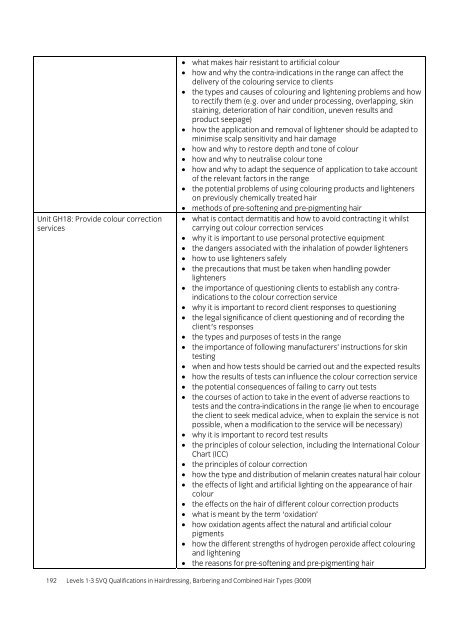3009 SVQ Assessment handbook v2 - City & Guilds
3009 SVQ Assessment handbook v2 - City & Guilds
3009 SVQ Assessment handbook v2 - City & Guilds
You also want an ePaper? Increase the reach of your titles
YUMPU automatically turns print PDFs into web optimized ePapers that Google loves.
Unit GH18: Provide colour correction<br />
services<br />
• what makes hair resistant to artificial colour<br />
• how and why the contra-indications in the range can affect the<br />
delivery of the colouring service to clients<br />
• the types and causes of colouring and lightening problems and how<br />
to rectify them (e.g. over and under processing, overlapping, skin<br />
staining, deterioration of hair condition, uneven results and<br />
product seepage)<br />
• how the application and removal of lightener should be adapted to<br />
minimise scalp sensitivity and hair damage<br />
• how and why to restore depth and tone of colour<br />
• how and why to neutralise colour tone<br />
• how and why to adapt the sequence of application to take account<br />
of the relevant factors in the range<br />
• the potential problems of using colouring products and lighteners<br />
on previously chemically treated hair<br />
• methods of pre-softening and pre-pigmenting hair<br />
• what is contact dermatitis and how to avoid contracting it whilst<br />
carrying out colour correction services<br />
• why it is important to use personal protective equipment<br />
• the dangers associated with the inhalation of powder lighteners<br />
• how to use lighteners safely<br />
• the precautions that must be taken when handling powder<br />
lighteners<br />
• the importance of questioning clients to establish any contraindications<br />
to the colour correction service<br />
• why it is important to record client responses to questioning<br />
• the legal significance of client questioning and of recording the<br />
client's responses<br />
• the types and purposes of tests in the range<br />
• the importance of following manufacturers’ instructions for skin<br />
testing<br />
• when and how tests should be carried out and the expected results<br />
• how the results of tests can influence the colour correction service<br />
• the potential consequences of failing to carry out tests<br />
• the courses of action to take in the event of adverse reactions to<br />
tests and the contra-indications in the range (ie when to encourage<br />
the client to seek medical advice, when to explain the service is not<br />
possible, when a modification to the service will be necessary)<br />
• why it is important to record test results<br />
• the principles of colour selection, including the International Colour<br />
Chart (ICC)<br />
• the principles of colour correction<br />
• how the type and distribution of melanin creates natural hair colour<br />
• the effects of light and artificial lighting on the appearance of hair<br />
colour<br />
• the effects on the hair of different colour correction products<br />
• what is meant by the term ‘oxidation’<br />
• how oxidation agents affect the natural and artificial colour<br />
pigments<br />
• how the different strengths of hydrogen peroxide affect colouring<br />
and lightening<br />
• the reasons for pre-softening and pre-pigmenting hair<br />
192 Levels 1-3 <strong>SVQ</strong> Qualifications in Hairdressing, Barbering and Combined Hair Types (<strong>3009</strong>)
















